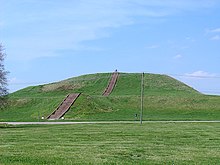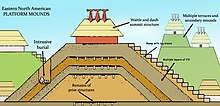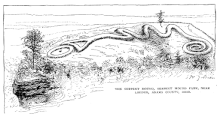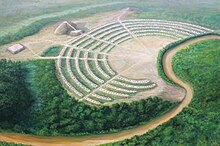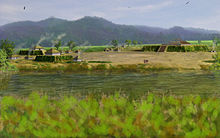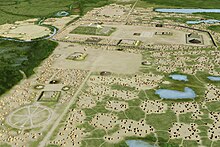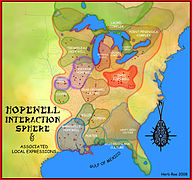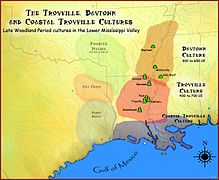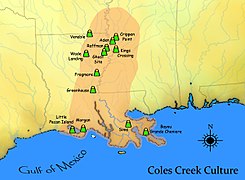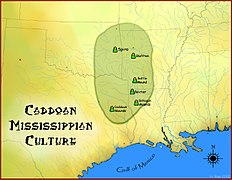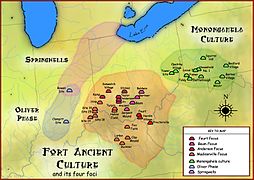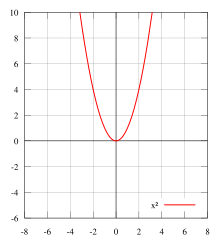A number of pre-Columbian cultures are collectively termed "Mound Builders". The term does not refer to a specific people or archaeological culture, but refers to the characteristic mound earthworks erected for an extended period of more than 5,000 years. The "Mound Builder" cultures span the period of roughly 3500 BCE (the construction of Watson Brake) to the 16th century CE, including the Archaic period, Woodland period (Calusa culture, Adena and Hopewell cultures), and Mississippian period. Geographically, the cultures were present in the region of the Great Lakes, the Ohio River Valley, and the Mississippi River valley and its tributary waters.
The first mound building was an early marker of political and social complexity among the cultures in the Eastern United States. Watson Brake in Louisiana, constructed about 3500 BCE during the Middle Archaic period, is currently the oldest known and dated mound complex in North America. It is one of 11 mound complexes from this period found in the Lower Mississippi Valley. These cultures generally had developed hierarchical societies that had an elite. These commanded hundreds or even thousands of workers to dig up tons of earth with the hand tools available, move the soil long distances, and finally, workers to create the shape with layers of soils as directed by the builders.
From about 800 CE, the mound building cultures were dominated by the Mississippian culture, a large archaeological horizon, whose youngest descendants, the Plaquemine culture and the Fort Ancient culture, were still active at the time of European contact in the 16th century. One tribe of the Fort Ancient culture has been identified as the Mosopelea, presumably of southeast Ohio, who were speakers of an Ohio Valley Siouan language. The bearers of the Plaquemine culture were presumably speakers of the Natchez language isolate. The first description of these cultures is due to Spanish explorer Hernando de Soto, written between 1540 and 1542.
Mounds
The namesake cultural trait of the Mound Builders was the building of mounds and other earthworks. These burial and ceremonial structures were typically flat-topped pyramids or platform mounds, flat-topped or rounded cones, elongated ridges, and sometimes a variety of other forms. They were generally built as part of complex villages. The early earthworks built in Louisiana around 3500 BCE are the only ones known to have been built by a hunter-gatherer culture, rather than a more settled culture based on agricultural surpluses.
The best-known flat-topped pyramidal structure is Monks Mound at Cahokia, near present-day Collinsville, Illinois. This mound appears to have been the main ceremonial and residential mound for the religious and political leaders; it is more than 100 feet (30 m) tall and is the largest pre-Columbian earthwork north of Mexico. This site had numerous mounds, some with conical or ridge tops, as well as a Woodhenge, and palisaded stockades protecting the large settlement and elite quarter. At its maximum about 1150 CE, Cahokia was an urban settlement with 20,000–30,000 people; this population was not exceeded by North American European settlements until after 1800.
Some effigy mounds were constructed in the shapes or outlines of culturally significant animals. The most famous effigy mound, Serpent Mound in southern Ohio, ranges from 1 foot (0.30 m) to just over 3 feet (0.91 m) tall, 20 feet (6.1 m) wide, more than 1,330 feet (410 m) long, and shaped as an undulating serpent.
Early descriptions
Between 1540 and 1542, Hernando de Soto, the Spanish conquistador, traversed what became the southeastern United States. There he encountered many different mound-builder peoples who were perhaps descendants of the great Mississippian culture. De Soto observed people living in fortified towns with lofty mounds and plazas, and surmised that many of the mounds served as foundations for priestly temples. Near present-day Augusta, Georgia, de Soto encountered a group ruled by a queen, Cofitachequi. She told him that the mounds within her territory served as the burial places for nobles.
The artist Jacques le Moyne, who had accompanied French settlers to northeastern Florida during the 1560s, likewise noted Native American groups using existing mounds and constructing others. He produced a series of watercolor paintings depicting scenes of native life. Although most of his paintings have been lost, some engravings were copied from the originals and published in 1591 by a Flemish company. Among these is a depiction of the burial of an aboriginal Floridian tribal chief, an occasion of great mourning and ceremony. The original caption reads:
Sometimes the deceased king of this province is buried with great solemnity, and his great cup from which he was accustomed to drink is placed on a tumulus with many arrows set about it.
— Jacques le Moyne, 1560s
Maturin Le Petit, a Jesuit priest, met the Natchez people, as did Le Page du Pratz (1758), a French explorer. Both observed them in the area that today is known as Mississippi. The Natchez were devout worshippers of the sun. Having a population of some 4,000, they occupied at least nine villages and were presided over by a paramount chief, known as the Great Sun, who wielded absolute power. Both observers noted the high temple mounds which the Natchez had built so that the Great Sun could commune with God, the sun. His large residence was built atop the highest mound, from "which, every morning, he greeted the rising sun, invoking thanks and blowing tobacco smoke to the four cardinal directions".
Archaeological surveys
The most complete reference for these earthworks is Ancient Monuments of the Mississippi Valley, written by Ephraim G. Squier and Edwin H. Davis. It was published in 1848 by the Smithsonian Institution. Since many of the features which the authors documented have since been destroyed or diminished by farming and development, their surveys, sketches, and descriptions are still used by modern archaeologists. All of the sites which they identified as located in Kentucky came from the manuscripts of C. S. Rafinesque.
Chronology
Archaic era
Radiocarbon dating has established the age of the earliest Archaic mound complex in southeastern Louisiana. One of the two Monte Sano Site mounds, excavated in 1967 before being destroyed for new construction at Baton Rouge, was dated at 6220 BP (plus or minus 140 years). Researchers at the time thought that such societies were not organizationally capable of this type of construction. It has since been dated as about 6500 BP, or 4500 BCE, although not all agree.
Watson Brake is located in the floodplain of the Ouachita River near Monroe in northern Louisiana. Securely dated to about 5,400 years ago (around 3500 BCE), in the Middle Archaic period, it consists of a formation of 11 mounds from 3 feet (0.91 m) to 25 feet (7.6 m) tall, connected by ridges to form an oval nearly 900 feet (270 m) across. In the Americas, building of complex earthwork mounds started at an early date, well before the pyramids of Egypt were constructed. Watson Brake was being constructed nearly 2,000 years before the better-known Poverty Point, and building continued for 500 years. Middle Archaic mound construction seems to have ceased about 2800 BCE, and scholars have not ascertained the reason, but it may have been because of changes in river patterns or other environmental factors.
With the 1990s dating of Watson Brake and similar complexes, scholars established that pre-agricultural, pre-ceramic American societies could organize to accomplish complex construction during extended periods of time, invalidating scholars' traditional ideas of Archaic society. Watson Brake was built by a hunter-gatherer society, the people of which occupied the area on only a seasonal basis, but where successive generations organized to build the complex mounds over a 500-year period. Their food consisted mostly of fish and deer, as well as available plants.
Poverty Point, built about 1500 BCE in what is now Louisiana, is a prominent example of Late Archaic mound-builder construction (around 2500 BCE – 1000 BCE). It is a striking complex of more than 1 square mile (2.6 km2), where six earthwork crescent ridges were built in concentric arrangement, interrupted by radial aisles. Three mounds are also part of the main complex, and evidence of residences extends for about 3 miles (4.8 km) along the bank of Bayou Macon. It is the major site among 100 associated with the Poverty Point culture and is one of the best-known early examples of earthwork monumental architecture. Unlike the localized societies during the Middle Archaic, this culture showed evidence of a wide trading network outside its area, which is one of its distinguishing characteristics.
Horr's Island, Florida, now a gated community next to Marco Island, when excavated by Michael Russo in 1980 found an Archaic Indian village site. Mound A was a burial mound that dated to 3400 BCE, making it the oldest known burial mound in North America.
Woodland period
The oldest mound associated with the Woodland period was the mortuary mound and pond complex at the Fort Center site in Glade County, Florida. 2012 excavations and dating by Thompson and Pluckhahn show that work began around 2600 BCE, seven centuries before the mound-builders in Ohio.
The Archaic period was followed by the Woodland period (circa 1000 BCE). Some well-understood examples are the Adena culture of Ohio, West Virginia, and parts of nearby states. The subsequent Hopewell culture built monuments from present-day Illinois to Ohio; it is renowned for its geometric earthworks. The Adena and Hopewell were not the only mound-building peoples during this time period. Contemporaneous mound-building cultures existed throughout what is now the Eastern United States, stretching as far south as Crystal River in western Florida. During this time, in parts of present-day Mississippi, Arkansas, and Louisiana, the Hopewellian Marksville culture degenerated and was succeeded by the Baytown culture. Reasons for degeneration include attacks from other tribes or the impact of severe climatic changes undermining agriculture.
Coles Creek culture
The Coles Creek culture is a Late Woodland culture (700–1200 CE) in the Lower Mississippi Valley in the Southern United States that marks a significant change of the cultural history of the area. Population and cultural and political complexity increased, especially by the end of the Coles Creek period. Although many of the classic traits of chiefdom societies were not yet made, by 1000 CE, the formation of simple elite polities had begun. Coles Creek sites are found in Arkansas, Louisiana, Oklahoma, Mississippi, and Texas. The Coles Creek culture is considered ancestral to the Plaquemine culture.
Mississippian cultures
Around 900–1450 CE, the Mississippian culture developed and spread through the Eastern United States, primarily along the river valleys. The largest regional center where the Mississippian culture is first definitely developed is located in Illinois near the Mississippi, and is referred to presently as Cahokia. It had several regional variants including the Middle Mississippian culture of Cahokia, the South Appalachian Mississippian variant at Moundville and Etowah, the Plaquemine Mississippian variant in south Louisiana and Mississippi, and the Caddoan Mississippian culture of northwestern Louisiana, eastern Texas, and southwestern Arkansas. Like the mound builders of the Ohio, these people built gigantic mounds as burial and ceremonial places.
Fort Ancient culture
Fort Ancient is the name for a Native American culture that flourished from 1000 to 1650 CE among a people who predominantly inhabited land along the Ohio River in areas of modern-day southern Ohio, northern Kentucky, and western West Virginia.
Plaquemine culture
A continuation of the Coles Creek culture in the lower Mississippi River Valley in western Mississippi and eastern Louisiana. Examples include the Medora site in West Baton Rouge Parish, Louisiana; and the Anna and Emerald Mound sites in Mississippi. Sites inhabited by Plaquemine peoples continued to be used as vacant ceremonial centers without large village areas much as their Coles Creek ancestors had done, although their layout began to show influences from Middle Mississippian peoples to the north. The Winterville and Holly Bluff (Lake George) sites in western Mississippi are good examples that exemplify this change of layout, but continuation of site usage. During the Terminal Coles Creek period (1150 to 1250 CE), contact increased with Mississippian cultures centered upriver near St. Louis, Missouri. This resulted in the adaption of new pottery techniques, as well as new ceremonial objects and possibly new social patterns during the Plaquemine period. As more Mississippian culture influences were absorbed, the Plaquemine area as a distinct culture began to shrink after CE 1350. Eventually, the last enclave of purely Plaquemine culture was the Natchez Bluffs area, while the Yazoo Basin and adjacent areas of Louisiana became a hybrid Plaquemine-Mississippian culture. This division was recorded by Europeans when they first arrived in the area. In the Natchez Bluffs area, the Taensa and Natchez people had held out against Mississippian influence and continued to use the same sites as their ancestors, and the Plaquemine culture is considered directly ancestral to these historic period groups encountered by Europeans. Groups who appear to have absorbed more Mississippian influence were identified as those tribes speaking the Tunican, Chitimachan, and Muskogean languages.
Disappearance
Following the description by Jacques le Moyne in 1560, the mound building cultures seem to have disappeared within the next century. However, there were also other European accounts, earlier than 1560, that gives a first-hand description of the enormous earth-built mounds being constructed by the Native Americans. One of them was Garcilaso de la Vega (c.1539–1616), a Spanish chronicler also known as "El Inca" because of his Incan mother, who was also the record-keeper of the infamous De Soto expedition that landed in present-day Florida on May 31, 1538. Garcilaso gave a first-hand description through his Historia de la Florida (published in 1605, Lisbon, as La Florida del Inca) describing how the Indians had built mounds and how the Native American Mound Cultures practiced their traditional way of life. De la Vega's accounts also include vital details about the Native American tribes' systems of government present in the South-East, tribal territories, and construction of mounds and temples. A few French expeditions in 1560s reported staying with Indian societies who had built mounds also.
Diseases
Later explorers to the same regions, only a few decades after mound-building settlements had been reported, found the regions largely depopulated with its residents vanished and the mounds untended. Conflicts with Europeans were dismissed by historians as the major cause of populations reduction, since only few clashes had occurred between the natives and the Europeans in the area during the same period. The most-widely accepted explanation behind the disappearances were the infectious diseases from the Old World, such as smallpox and influenza, which had decimated most of the Native Americans from the last mound-builder civilization. The Fort Ancient culture of the Ohio River valley is considered a "sister culture" of the Mississippian horizon, or one of the "Mississippianised" cultures adjacent to the main areal of the mound building cultures. This culture was also mostly extinct in the 17th century, but remnants may have survived into the first half of the 18th century. While this culture shows strong Mississippian influences, its bearers were most likely ethno-linguistically distinct from the Mississippians, possibly belonging to the Siouan phylum. The only tribal name associated with the Fort Ancient culture in the historical record are the Mosopelea, recorded by Jean-Baptiste-Louis Franquelin in 1684 as inhabiting eight villages north of the Ohio River. The Mosopelea are most likely identical to the Ofo (Oufé, Offogoula) recorded in the same area in the 18th century. The Ofo language was formerly classified as Muskogean but is now recognized as an eccentric member of the Western Siouan phylum. The late survival of the Fort Ancient culture is suggested by the remarkable amount of European made goods in the archaeological record which would have been acquired by trade even before direct European contact. These artefacts include brass and steel items, glassware, and melted down or broken goods reforged into new items. The Fort Ancient peoples are known to have been severely affected by disease in the 17th century (Beaver Wars period), and Carbon dating seems to indicate that they were wiped out by successive waves of disease.
Massacre and revolt
Because of the disappearance of the cultures by the end of the 17th century, the identification of the bearers of these cultures was an open question in 19th-century ethnography. Modern stratigraphic dating has established that the "Mound builders" have spanned the extended period of more than five millennia, so that any ethno-linguistic continuity is unlikely. The spread of the Mississippian culture from the late 1st millennium CE most likely involved cultural assimilation, in archaeological terminology called "Mississippianised" cultures.
19th-century ethnography assumed that the Mound-builders were an ancient prehistoric race with no direct connection to the Southeastern Woodland peoples of the historical period. A reference to this idea appears in the poem "The Prairies" (1832) by William Cullen Bryant.
The cultural stage of the Southeastern Woodland natives encountered in the 18th and 19th centuries by British colonists was deemed incompatible with the comparatively advanced stone, metal, and clay artifacts of the archaeological record. The age of the earthworks was also partly over-estimated. Caleb Atwater's misunderstanding of stratigraphy caused him to significantly overestimate the age of the earthworks. In his book, Antiquities Discovered in the Western States (1820), Atwater claimed that "Indian remains" were always found right beneath the surface of the earth, while artifacts associated with the Mound Builders were found fairly deep in the ground. Atwater argued that they must be from a different group of people. The discovery of metal artifacts further convinced people that the Mound Builders were not identical to the Southeast Woodland Native Americans of the 18th century.
It is now thought that the most likely bearers of the Plaquemine culture, a late variant of the Mississippian culture, were ancestral to the related Natchez and Taensa peoples. The Natchez language is a language isolate, supporting the scenario that after the collapse of the Mound builder cultures in the 17th century, there was an influx of unrelated peoples into the area. The Natchez are known to have historically occupied the Lower Mississippi Valley. They are first mentioned in French sources of around 1700, when they were centuered around the Grand Village close to present day Natchez, Mississippi. In 1729 the Natchez revolted, and massacred the French colony of Fort Rosalie, and the French retaliated by destroying all the Natchez villages. The remaining Natchez fled in scattered bands to live among the Chickasaw, Creek and Cherokee, whom they followed on the trail of tears when Indian removal policies of the mid 19th century forced them to relocate to Oklahoma. The Natchez language was extinct in the 20th century, with the death of the last known native speaker, Nancy Raven, in 1957.
Maps
Popular mythology
Alternative scenarios and hoaxes
Based on the idea that the origins of the mound builders lay with a mysterious ancient people, there were various other suggestions belonging to the more general genre of Pre-Columbian trans-oceanic contact theories, specifically involving Vikings, Atlantis, and the Ten Lost Tribes of Israel, summarised by Feder (2006) under the heading of "The Myth of a Vanished Race".
Benjamin Smith Barton in his Observations on Some Parts of Natural History (1787) proposed the theory that the Mound Builders were associated with "Danes", i.e. with the Norse colonization of North America. In 1797, Barton reconsidered his position and correctly identified the mounds as part of indigenous prehistory.
Notable for the association with the Ten Lost Tribes is the Book of Mormon (1830). In this narrative, the Jaredites (3000–2000 BCE) and an Israelite group in 590 BCE (termed Nephites, Lamanites, and Mulekites). While the Nephites, Lamanites, and Mulekites were all of Jewish origin coming from Israel around 590 BCE, the Jaradites were a non-Abrahamic people separate in all aspects, except in a belief in Jehovah, from the Nephites. The Book of Mormon depicts these settlers building magnificent cities, which were destroyed by warfare about CE 385. The Book of Mormon can be placed in the tradition of the "Mound-Builder literature" of the period. Dahl (1961) states that it is "the most famous and certainly the most influential of all Mound-Builder literature". Later authors placing the Book of Mormon in this context include Silverberg (1969), Brodie (1971), Kennedy (1994) and Garlinghouse (2001).
Some nineteenth-century archaeological finds (e.g., earth and timber fortifications and towns, the use of a plaster-like cement, ancient roads, metal points and implements, copper breastplates, head-plates, textiles, pearls, native North American inscriptions, North American elephant remains etc.) were well-publicized at the time of the publication of the Book of Mormon and there is incorporation of some of these ideas into the narrative. References are made in the Book of Mormon to then-current understanding of pre-Columbian civilizations, including the formative Mesoamerican civilizations such as the (Pre-Classic) Olmec, Maya, and Zapotec.
Lafcadio Hearn in 1876 suggested that the mounds were built by people from the lost continent of Atlantis. The Reverend Landon West in 1901 claimed that Serpent Mound in Ohio was built by God, or by man inspired by him. He believed that God built the mound and placed it as a symbol of the story of the Garden of Eden.
More recently, Black nationalist websites claiming association with the Moorish Science Temple of America, have taken up the Atlantean ("Mu") association of the Mound Builders. Similarly, the "Washitaw Nation", a group associated with the Moorish Science Temple of America established in the 1990s, has been associated with mound-building in Black nationalist online articles of the early 2000s.
Kinderhook plates
On April 23, 1843, nine men unearthed human bones and six small, bell-shaped plates in Kinderhook, Illinois. Both sides of the plates apparently contained some sort of ancient writings. The plates, later known as the Kinderhook plates, were presented to Joseph Smith, who was an American religious leader and founder of Mormonism. He was reported to have said, "I have translated a portion of them, and find they contain the history of the person with whom they were found. He was a descendant of Ham, through the loins of Pharaoh, king of Egypt, and that he received his kingdom from the Ruler of heaven and earth."
In later letters, two eyewitnesses among the nine people who were present at the excavation of the plates, W. P. Harris and Wilbur Fugate, confessed that the whole thing was a hoax. With a group of other conspirators, they had manufactured the plates to give them the appearance of antiquity, buried them in a mound, and later pretended to excavate them, all for the purpose of trapping Joseph Smith into pretending to translate. However, it was not until 1980, when the only remaining plate was forensically examined, that the plates were conclusively determined to be, in fact, a nineteenth-century production.Up to 1980 most Latter-day Saints rejected the confessions and believed the plates were authentic. Not only did skeptics accept the confessors’ statements, but some continue to this day to argue that Joseph Smith pretended to translate a portion of the faked plates, claiming that he could not have been a true prophet.
The purpose for faking the Kinderhook plates is mainly to prove that the book of Mormon is true according to the witness Fulgate, "We learn there was a Mormon present when the plates were found, who it is said, leaped for joy at the discovery, and remarked that it would go to prove the authenticity of the Book of Mormon. The Mormons wanted to take the plates to Joe Smith, but we refused to let them go. Some time afterward a man assuming the name of Savage, of Quincy, borrowed the plates of Wiley to show to his literary friends there, and took them to Joe Smith."
Newark Holy Stone
On June 29, 1860, David Wyrick, the surveyor of Licking County near Newark, discovered the so called Keystone in a shallow excavation at the monumental Newark Earthworks, which is an extraordinary set of ancient geometric enclosures created by Indigenous people. There he dug up a four-sided, plumb-bob-shaped stone with Hebrew letters engraved on each of its faces. The local Episcopal minister John W. McCarty translated the four inscriptions as "Law of the Lord," “Word of the Lord," “Holy of Holies," and "King of the Earth." Charles Whittlesey, who was one of the foremost archaeologists at that time, pronounced the stone to be authentic. The Newark Holy Stones, if genuine, would provide support for monogenesis, since they would establish that American Indians could be encompassed within Biblical history.
After his first expedition, Wyrick uncovered a small stone box that was found to contain an intricately carved slab of black limestone covered with archaic-looking Hebrew letters along with a representation of a man in flowing robes. When translated, once again by McCarty, the inscription was found to include the entire Ten Commandments, and the robed figure was identified as Moses. Naturally enough, it became known as the Decalogue Stone.
Rather than being found beneath only a foot or two of soil, the Decalogue Stone was claimed to have been buried beneath a forty-foot-tall stone mound. Instead of modern Hebrew typography, the characters on the stone were blocky and appeared to be an ancient form of the Hebrew alphabet. Finally, the stone bore no resemblance to any modern Masonic artifact. In 1870, Whittlesey declared finally that the Holy Stones and other similar artifacts were "Archaeological Frauds."
Giants
In 19th-century America, a number of popular mythologies surrounding the origin of the mounds were in circulation, typically involving the mounds being built by a race of giants. A New York Times article from 1897 described a mound in Wisconsin in which a giant human skeleton measuring over 9 feet (2.7 m) in length was found. From 1886, another New York Times article described water receding from a mound in Cartersville, Georgia, which uncovered acres of skulls and bones, some of which were said to be gigantic. Two thigh bones were measured with the height of their owners estimated at 14 feet (4.3 m). President Lincoln made reference to the giants whose bones fill the mounds of America.
But still there is more. It calls up the indefinite past. When Columbus first sought this continent – when Christ suffered on the cross – when Moses led Israel through the Red-Sea – nay, even, when Adam first came from the hand of his Maker – then as now, Niagara was roaring here. The eyes of that species of extinct giants, whose bones fill the mounds of America, have gazed on Niagara, as ours do now. Co[n]temporary with the whole race of men, and older than the first man, Niagara is strong, and fresh to-day as ten thousand years ago. The Mammoth and Mastodon – now so long dead, that fragments of their monstrous bones, alone testify, that they ever lived, have gazed on Niagara. In that long – long time, never still for a single moment. Never dried, never froze, never slept, never rested.
The antiquarian author William Pidgeon in 1858 created fraudulent surveys of mound groups that did not exist.
Beginning in the 1880s, the supposed origin of the earthworks with a race of giants was increasingly recognized as spurious. Pidgeon's fraudulent claims about the archaeological record was shown to be a hoax by Theodore Lewis in 1886. A major factor contributing to public acceptance of the earthworks as a regular part of North American prehistory was the 1894 report by Cyrus Thomas of the Bureau of American Ethnology. Earlier authors making a similar case include Thomas Jefferson, who excavated a mound and from the artifacts and burial practices, noted similarities between mound-builder funeral practices and those of Native Americans in his time.
